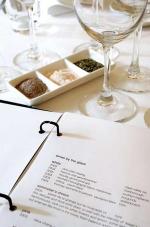Visit most any winemaking region the world over and you’ll find that restaurant wine lists are chock full of locally made wines. Go to a restaurant in Napa and you’ll find wine lists dominated by Napa wines rather than Spanish ones. In Tuscany, you’ll find Chianti and Super Tuscans, not Australian Shiraz. You get the idea.
But sit down at most East End restaurants and Long Island wines are far from the focus—if there are any on the list at all. I know that it makes me crazy when I’m out there and I want to drink a wine from a winery I’m not visiting that day and all I see on the list are names like Yellow Tail, Beringer, Mondavi and Cavit.
There are exceptions of course. Places like Fifth Season (Greenport) and North Fork Table (Southold) have lists with plenty of local options. Unfortunately, Fifth Season ignores many top bottles, but hey, at least they focus on local, right?
Sadly these types of forward-thinking restaurants are the exception rather than the rule however. Then again, is it really forward thinking if much of the world is already acting this way?
Many local winemakers and winery owners aren’t happy about this situation, saying that local restaurants should support the wine industry better. Many restaurants respond by pointing to high prices and low demand as two major reasons they don’t.
Both sides of the argument are right—to a point. What is really needed is an partnership between the two groups. One founded in a common goal—financial success.
So how do we get there? Here’s my take.
Wineries shouldn’t expect restaurants to approach them. If
you want your wines on more lists—put a mixed case of wines in your
trunk and hit the road. Obviously many of you are already doing this,
but be even more diligent and pushy if need be. Keep going back and
taste with the chefs if you can. They can be your in-restaurant
champions.
Restaurants need to pick better wines for their lists.
Don’t just pay lip service to “pouring local” —do it well. Too many
restaurants pour only one or two cheap, insipid Long Island wines that
don’t the region any favors. If a customer tries local wines for the
first time at those restaurants, they aren’t going to have a good
experience, the restaurant look bad and demand for local wines is
diminished. Put good bottles on your list—or none at all. Only offering
Pindar’s Winter White does the entire region a disservice.
Price the wines so restaurants can profit and customers will buy them.
No one is suggesting that you should give your wines away just to get
them on lists, but restaurants need to make money and a large
percentage of their money is made on alcohol. At the same time, marking
up a $35 red blend to $100 or more is ridiculous. Be reasonable and
you’ll sell more wine. There’s got to be a price point at which winery,
restaurant and customer all benefit, right?
Remember that this is a symbiotic relationship. This seems
obvious, but in the craziness of running a winery or restaurant, it
might get lost. If the wineries succeed, that brings more people to
wine country—more people who will need to eat somewhere. And, if the
restaurants introduce new people to local wines, the wineries benefit
as well.
Long Island wine lovers should be asking for them at their favorite restaurants. I
order Long Island wine almost every time I dine out. I do so not
because I’m blindly supporting a region and industry that I care about,
but because the wines are so food friendly—particularly when compared
to many wines from California, Australia and South America.
End of rant…but I really hope the region can come together b

